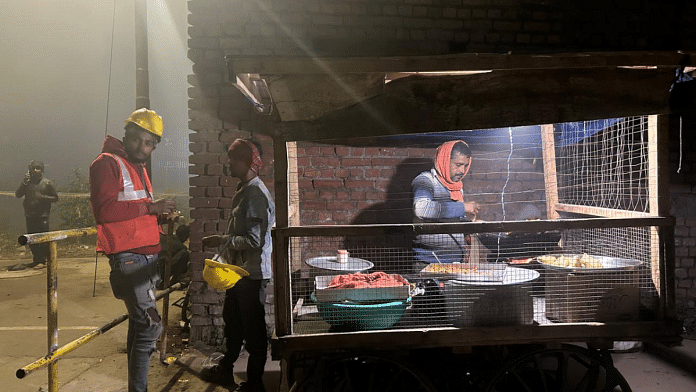Ayodhya: Tribhuvan Sharma, 23, relished his first meal of the day — a samosa with green chutney — from the roadside food stall at 10 pm in the night. Wearing a yellow safety helmet, Sharma awaited his colleague Mohammad Ajmad to set out for the Ram temple construction site
Despite already having worked for 12 hours, Sharma geared up for another shift. The first phase of the Ram temple has to be completed before 15 January for which Sharma and hundreds of other labourers were hired two weeks ago.
Sharma, a farm labourer in Noida, was hired as a welder along with Ajmad who worked in Chandigarh. Both were hired by the same contractor, and they share a room along with six others at the labour colony.
“I will now work till 3 am in the morning. Come back, have some rest, and leave again at 8 am,” Sharma said before he asked the food stall owner for another samosa.
The labour colony, popularly known as L&T colony, in Ayodhya is teeming with construction workers. At 10 pm, construction workers bustled about – some returning from work, others stopping to eat at the food stall, while another batch headed to the temple construction site.
The first phase of construction, integral to the inauguration, includes the completion of the ground floor, entrance and sanctum where the deity will be placed.
“The first phase is almost complete. It will take another 10-15 days. We have been asked to work round-the-clock so that the temple is inaugurated successfully. After that, the labourers will be given some time off,” said Jinu Prasad, a supervisor with L&T company.
The Ram temple will be inaugurated on 22 January by PM Narendra Modi along with Uttar Pradesh Chief Minister Yogi Adityanath. Nearly 8,000 dignitaries, including seers, industrialists, VVIPS, actors, Padam Bushan awardees, are invited for the grand event.
Also Read: Ram Aayenge is the new Ayodhya anthem. But race to sing at Ram temple opening heating up
Modest accommodation
About 100 metre behind the main construction site is the labour colony, where temporary tin hutments are home to the workers engaged in the project for nearly two years.
The compound has a modest community kitchen, while the rooms resemble small dormitories with bunk beds. With only 100 rooms, each of them are packed to accommodate 1,500 labourers. There is no provision for hot water for the occupants of the cold tin rooms.
Buddh Singh has been working for the last one year at the Ayodhya temple site. Singh’s work involves cutting and chiselling the stones into slabs, and passing them on to other sections of the construction workforce.
Singh claimed that he had earlier worked at Delhi’s Akshardham temple), and added that the workload and pressure was not as intense.
“The work has to be completed by any means. We have been given a deadline to complete the temple by 2024 December. But currently, the inauguration is the primary goal,” Singh said, holding a bag of onion and tomatoes.
As per the sources from the Vishva Hindu Parishad (VHP), the construction of the temple will culminate by 15 January and the beautification and cleaning of temple will take over in the last week.
The meals are covered by the contractors and the construction workers don’t have to pay for the accommodation, but the strenuous work hours are breaking their backs.
“We are working more than 14 hours in a day,” a worker said.
But despite long work hours and double shifts, faith reigns supreme as the workers claim that they are blessed to be participating in the project and that Lord Ram would make their life easier in the future.
“We must have done something right in our life that we were called by Lord Ram to construct a temple for him. At 55, I don’t feel tired despite working all day because it is God’s work. God will take care of us,” said Vijay Ram from Rajasthan.
(Edited by Tony Rai)
Also Read: These Ayodhya houses have a front row view of Ram temple. They are also on security radar






